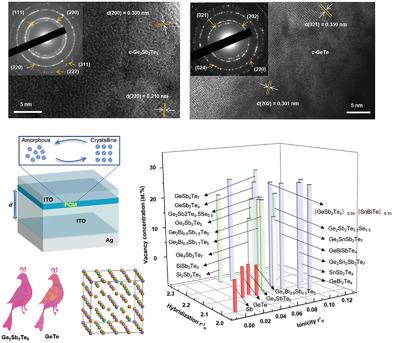当前位置:
X-MOL 学术
›
Adv. Opt. Mater.
›
论文详情
Our official English website, www.x-mol.net, welcomes your
feedback! (Note: you will need to create a separate account there.)
Phase Change Materials for Nonvolatile, Solid‐State Reflective Displays: From New Structural Design Rules to Enhanced Color‐Changing Performance
Advanced Optical Materials ( IF 8.0 ) Pub Date : 2020-03-12 , DOI: 10.1002/adom.202000062 Shuaipeng Tao 1 , Qian Li 1 , Jiafu Wang 1 , Xiaoyi Wang 2 , Jize Cai 1 , Shibo Li 1 , Wei Xu 1 , Kan Zhang 1 , Chaoquan Hu 1
Advanced Optical Materials ( IF 8.0 ) Pub Date : 2020-03-12 , DOI: 10.1002/adom.202000062 Shuaipeng Tao 1 , Qian Li 1 , Jiafu Wang 1 , Xiaoyi Wang 2 , Jize Cai 1 , Shibo Li 1 , Wei Xu 1 , Kan Zhang 1 , Chaoquan Hu 1
Affiliation

|
With the arrival of omnimedia era, there has been an increasing demand for energy‐saving, colorful, and portable displays. Traditional display technologies, such as electrophoresis and electronic ink display suffer from low color switching speed and poor color richness. Due to their high performances, phase change materials (PCMs)‐based nonvolatile, solid‐state reflective display coatings have become the most promising materials for new portable display technology. Existing researches mainly focus on improving the color‐changing performance of coatings by optimizing film structural parameters, but ignore improving the performance by designing new PCMs. Here, this study reveals the color‐changing mechanisms of display coatings through a combination of experiments, first‐principles calculations, spectral fitting, and optical simulation. It is found that reducing the vacancy concentrations of PCMs can increase the color‐changing performance of coatings owing to the increase in p–p coupling strength. Based on previous reports and the new insights into p–p coupling strength, this study proposes three structural design principles of ideal PCMs (low ionicity, a limited degree of hybridization, and high p–p coupling strength) and predicts new PCM candidates for display applications. This study opens a broad avenue for developing nonvolatile display technologies and material selection.
中文翻译:

非易失性固态反射型显示器的相变材料:从新的结构设计规则到增强的变色性能
随着多媒体时代的到来,对节能,彩色和便携式显示器的需求不断增长。诸如电泳和电子墨水显示器之类的传统显示技术遭受低的颜色切换速度和差的色彩丰富度的困扰。由于其高性能,基于相变材料(PCM)的非易失性固态反射显示涂层已成为新型便携式显示技术最有希望的材料。现有的研究主要集中在通过优化薄膜结构参数来改善涂料的变色性能,而忽略了通过设计新的PCM来改善性能。在这里,这项研究通过实验,第一性原理计算,光谱拟合和光学模拟的结合揭示了显示涂层的变色机理。已经发现,由于pp耦合强度的增加,降低PCM的空位浓度可以提高涂料的变色性能。基于以前的报告和对p-p耦合强度的新见解,本研究提出了理想PCM的三项结构设计原理(低离子度,有限的杂交度和高p-p耦合强度),并预测了新的PCM候选显示器应用程序。这项研究为开发非易失性显示技术和材料选择开辟了广阔的道路。这项研究提出了理想PCM的三种结构设计原理(低离子度,有限的杂交度和较高的p-p耦合强度),并预测了用于显示应用的新PCM候选材料。这项研究为开发非易失性显示技术和材料选择开辟了广阔的道路。这项研究提出了理想PCM的三种结构设计原理(低离子度,有限的杂交度和较高的p-p耦合强度),并预测了用于显示应用的新PCM候选材料。这项研究为开发非易失性显示技术和材料选择开辟了广阔的道路。
更新日期:2020-03-12
中文翻译:

非易失性固态反射型显示器的相变材料:从新的结构设计规则到增强的变色性能
随着多媒体时代的到来,对节能,彩色和便携式显示器的需求不断增长。诸如电泳和电子墨水显示器之类的传统显示技术遭受低的颜色切换速度和差的色彩丰富度的困扰。由于其高性能,基于相变材料(PCM)的非易失性固态反射显示涂层已成为新型便携式显示技术最有希望的材料。现有的研究主要集中在通过优化薄膜结构参数来改善涂料的变色性能,而忽略了通过设计新的PCM来改善性能。在这里,这项研究通过实验,第一性原理计算,光谱拟合和光学模拟的结合揭示了显示涂层的变色机理。已经发现,由于pp耦合强度的增加,降低PCM的空位浓度可以提高涂料的变色性能。基于以前的报告和对p-p耦合强度的新见解,本研究提出了理想PCM的三项结构设计原理(低离子度,有限的杂交度和高p-p耦合强度),并预测了新的PCM候选显示器应用程序。这项研究为开发非易失性显示技术和材料选择开辟了广阔的道路。这项研究提出了理想PCM的三种结构设计原理(低离子度,有限的杂交度和较高的p-p耦合强度),并预测了用于显示应用的新PCM候选材料。这项研究为开发非易失性显示技术和材料选择开辟了广阔的道路。这项研究提出了理想PCM的三种结构设计原理(低离子度,有限的杂交度和较高的p-p耦合强度),并预测了用于显示应用的新PCM候选材料。这项研究为开发非易失性显示技术和材料选择开辟了广阔的道路。











































 京公网安备 11010802027423号
京公网安备 11010802027423号